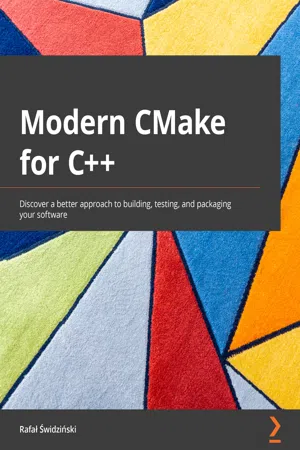
- 460 pages
- English
- ePUB (mobile friendly)
- Available on iOS & Android
Modern CMake for C++
About this book
Write comprehensive, professional-standard CMake projects and ensure the quality and simplicity of your solutionsPurchase of the print or Kindle book includes a free eBook in the PDF formatKey Features• Understand and automate compilation and linking with CMake• Manage internal and external dependencies easily• Add quality checks and tests as an inherent step for your buildsBook DescriptionCreating top-notch software is an extremely difficult undertaking. Developers researching the subject have difficulty determining which advice is up to date and which approaches have already been replaced by easier, better practices. At the same time, most online resources offer limited explanation, while also lacking the proper context and structure. This book offers a simpler, more comprehensive, experience as it treats the subject of building C++ solutions holistically. Modern CMake for C++ is an end-to-end guide to the automatization of complex tasks, including building, testing, and packaging. You'll not only learn how to use the CMake language in CMake projects, but also discover what makes them maintainable, elegant, and clean. The book also focuses on the structure of source directories, building targets, and packages. As you progress, you'll learn how to compile and link executables and libraries, how those processes work, and how to optimize builds in CMake for the best results. You'll understand how to use external dependencies in your project – third-party libraries, testing frameworks, program analysis tools, and documentation generators. Finally, you'll get to grips with exporting, installing, and packaging for internal and external purposes. By the end of this book, you'll be able to use CMake confidently on a professional level.What you will learn• Understand best practices for building C++ code• Gain practical knowledge of the CMake language by focusing on the most useful aspects• Use cutting-edge tooling to guarantee code quality with the help of tests and static and dynamic analysis• Discover how to manage, discover, download, and link dependencies with CMake• Build solutions that can be reused and maintained in the long term• Understand how to optimize build artifacts and the build process itselfWho this book is forThe book is for build engineers and software developers with knowledge of C/C++ programming who are looking to learn CMake to automate the process of building small and large software solutions. If you are someone who's just getting started with CMake, a long-time GNU Make user, or simply looking to brush up on the latest best practices, this book is for you.
Frequently asked questions
- Essential is ideal for learners and professionals who enjoy exploring a wide range of subjects. Access the Essential Library with 800,000+ trusted titles and best-sellers across business, personal growth, and the humanities. Includes unlimited reading time and Standard Read Aloud voice.
- Complete: Perfect for advanced learners and researchers needing full, unrestricted access. Unlock 1.4M+ books across hundreds of subjects, including academic and specialized titles. The Complete Plan also includes advanced features like Premium Read Aloud and Research Assistant.
Please note we cannot support devices running on iOS 13 and Android 7 or earlier. Learn more about using the app.
Information
Section 1: Introducing CMake
- Chapter 1, First Steps with CMake
- Chapter 2, The CMake Language
- Chapter 3, Setting Up Your First CMake Project
Chapter 1: First Steps with CMake
- Understanding the basics
- Installing CMake on different platforms
- Mastering the command line
- Navigating the project files
- Discovering scripts and modules
Technical requirements
Understanding the basics
What is CMake?
Table of contents
- Modern CMake for C++
- Contributors
- Preface
- Section 1: Introducing CMake
- Chapter 1: First Steps with CMake
- Chapter 2: The CMake Language
- Chapter 3: Setting Up Your First CMake Project
- Section 2: Building With CMake
- Chapter 4: Working with Targets
- Chapter 5: Compiling C++ Sources with CMake
- Chapter 6: Linking with CMake
- Chapter 7: Managing Dependencies with CMake
- Section 3: Automating With CMake
- Chapter 8: Testing Frameworks
- Chapter 9: Program Analysis Tools
- Chapter 10: Generating Documentation
- Chapter 11: Installing and Packaging
- Chapter 12: Creating Your Professional Project
- Appendix: Miscellaneous Commands
- Other Books You May Enjoy